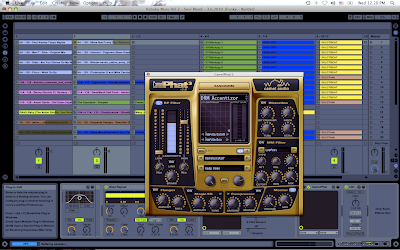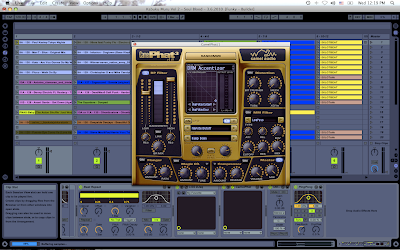When using filters in ableton live, I prefer to use Camel Phat 3 rather than ableton's built in filters. Abletons filters are more like production filters, and also seem to have a small audible difference even when left on (without actually filtering). Camel phat filter can sit ON within a track without actually changing the audio at all. So I like to use this.
Now, in order for this to work, you must be using a controller that allows you to have 2 knobs (one for low pass, and one for high pass) on each track that you are mixing. I have them mapped out to my VCM 600 where normal "send 1" and "send b" are....because I use them so much...and dont use sends too much when DJing.
SOMETHING TO KEEP IN MIND WHEN USING CAMEL PHAT 3. For some stupid reason, within the VST....the LOW is high pass and HIGH is low pass. Dont ask me why. So when mapping them to a controller...take this into consideration.
Also, I like my low pass and high pass to both activate when moving the knob from the LEFT to the RIGHT. (unlike what it is actually doing on the EQ spectrum). So you will need to inverse one of them (in map mode) to make them both go the same way if you want to do it this way. For the purpose of understanding this tutorial, think of the knobs as being OFF when in the LEFT position, and fully activated when in the RIGHT position. (for both high and low pass)
Also, please make note of these 2 important numbers "11 oclock" & "2 oclock".
We will refer to the knobs on the controller as if they were a CLOCK, and the position being the TIME on the clock.
1. OK......so lets talk about a filter OUT of a track first. Lets say, you are getting ready to mix track A and track B. Normally, someone would cut the lows out of the old track, (and possibly the new track) and then mix the beats together. Since I usually mix during ambient parts (because everything is warped and this is possible), it is not necessary to cut lows really...because there are no beats overlapping. So, a nice trick to filter out track A (rather than using volume & EQ)
To filter out, just start turning your low pass or high pass out as the new track is coming in. This is a simple technique, that really does not need much explaining. You can make the whole track disappear by filtering it out the whole way.
2. Now, lets talk about a filter IN of a new track. This is where "11oclock" and "2oclock" come in handy. Since the range of the BASS end of the spectrum is much smaller than the HIGH end, yet a knob must be able to go through ALL the spectrum in less than 360 degrees, LOW is much more sensitive to your knob then the HIGHS are. In other words, when you start to use a LOW PASS FILTER, the beginning of the low pass will react more quickly than the high pass. The opposite is true to the high pass. The beginning will react much less drastically than the ending of it. So, if you are going to FADE in with a filter....its good to start with either your LOW PASS at 11 oclock, or your HIGH PASS at 2 oclock. (this is just from experience with this method)
On Camel Phat, Low pass looks like this -

High pass looks like this -

Now, if you are fading in a track with a high pass...set it at 2 oclock. Then, as that track starts, slowly start moving it to the left until the track is unfiltered. This will make a nice high pass fade in effect. On the other hand, you may want a more muffled low pass sound. So, set your low pass at 11 oclock, and move it to the left until it is unfiltered. This is a great effect for bringing in a KICK drum from out of the lower frequencies. I tend to think bringing in high hats sounds good with a high pass, and kicks with a low pass. But it can sound good both ways.
Now remember, you could use other placement than 11 oclock, and 2 oclock, but on club speakers...using a high pass starting in at a higher value than 2 oclock tends to sound VERY loud and TOO HIGH when mixing. Low pass sitting at anything higher than 11oclock tends to not even be heard. Just some hints, but sometimes it may work using other clock positions.
Now, once youve tried this, its time to really get into understanding mixing with filters. When you do this, you are playing with mostly low and high frequencies. But, when mixing, I think its best to mix within the mids because it is the cleanest sound to the ear. But by using the 2 together, you can in a band pass filter style, which sounds the best, and what I do most of the time.
3. Lets talk about FADING OUT A TRACK again. Instead of using just one low pass or high pass, lets use them both together. Lets not forget the sensitivity range of both. When a track is being filtered out into disappearing....use both together. Remember to move the HIGH PASS a little MORE than the low pass. This will make the filter out within the mid range rather than the LOW or high, and sounds MUCH CLEANER for mixing.
4. Now lets talk about using a LOW pass on one track, and a high pass on the other. Lets say your mix point is coming up....and you want to bring in track B with a high pass filter, then filter out track A with a low pass. Set track Bs high pass filter to 2 oclock. Then, start the mix. Start bringing in that high pass filter, and at the same time start using the low pass on track A. Filter out track A with a low pass until it disappears, and remove that high pass on track B until it is unfiltered. It makes for a nice mix. You could also do this with a HIGH PASS and a HIGH PASS or a LOW PASS and a LOW PASS. They both sound nice. If you are good at turning 3 knobs at the same time...like shiva...you could apply all these techniques, and for instance...bring in track B (high pass at 2 oclock), and at the same time, filter out track A with a low pass AND a high pass. This makes track A disappear in the mid frequencies, and then track 2 comes in from the mid frequencies until it is unfiltered, and then playing at its normal sound. ALSO, you can get really crazy, and use 4 knobs at the same time. Bring in track B using both, and fitler out track A using both. This is the best....because you can mix out in the exact frequency you are looking for.
Remember that when using filters, the way it sounds at home, is a lot different than how it sounds in the club. For some reason, it seems to sound MORE SENSITIVE on the high frequencies on your home speakers than in the club...usually because you are using mixing monitors rather than club speakers. So it usually sounds even better and softer in the club than it does at home...which is nice. Also remember, when in the club, what you are hearing in your booth monitors in NOT what people are hearing. So, I would sound check your set up, and have someone move your filters while you listen out on the normal speakers so you know exactly what the people are hearing when you mix this way.
I almost always use this technique, because I am totally removing frequencies in a fading fashion rather than changing the frequency db of each. I like the way it sounds, and I like mixing within fading frequencies.
Anyway, give it a shot. If you dont like it, go back to EQing. Its pretty simple however. You could try mixing with an EQ 8 to get a better sounding mix too, but that is for another blog.
Peace!
FroBot



5 comments:
nice method, how to use side-chain effect for lows and highs pass when two songs or more get mixed together? (to have the pumping effect)
I dont side chain much live due to the unpredictable sound it may have on the speakers in the club. You can do it however, but you need to have your routing set up right. If you prepared and tested it, you could.
Also, you would be best to run a blank kick track and route it to the side chain of one of the tracks, rather than ONE other song do it...because you would def need to set which frequency range activates the sidechain...if not, it wont be very pumping if you are using a whole track, and all the frequencies are activating the sidechain. Have a blank kick track, matched in tempo of course, and let it do the pumping. Kind of like a dummy track.
great. thx
Hi quite interesting post , I am making an electronic music , here is my resource https://www.lucidsamples.com/deep-house-samples-packs/204-deep-house-progressions.html
What about u?
Post a Comment